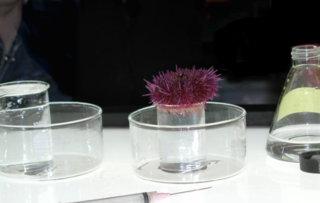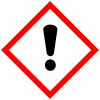Related Research Articles

Toxicity is the degree to which a chemical substance or a particular mixture of substances can damage an organism. Toxicity can refer to the effect on a whole organism, such as an animal, bacterium, or plant, as well as the effect on a substructure of the organism, such as a cell (cytotoxicity) or an organ such as the liver (hepatotoxicity). By extension, the word may be metaphorically used to describe toxic effects on larger and more complex groups, such as the family unit or society at large. Sometimes the word is more or less synonymous with poisoning in everyday usage.

Vinyl chloride is an organochloride with the formula H2C=CHCl. It is also called vinyl chloride monomer (VCM) or chloroethene. This colorless compound is an important industrial chemical chiefly used to produce the polymer, poly(vinyl chloride) (PVC). Vinyl chloride monomer is among the top twenty largest petrochemicals (petroleum-derived chemicals) in world production. The United States remains the largest vinyl chloride manufacturing region because of its low-production-cost position in chlorine and ethylene raw materials. China is also a large manufacturer and one of the largest consumers of vinyl chloride. Vinyl chloride is a flammable gas that has a sweet odor and is carcinogenic. It can be formed in the environment when soil organisms break down chlorinated solvents. Vinyl chloride that is released by industries or formed by the breakdown of other chlorinated chemicals can enter the air and drinking water supplies. Vinyl chloride is a common contaminant found near landfills. Before the 1970s, vinyl chloride was used as an aerosol propellant and refrigerant.

Piperonyl butoxide (PBO) is a pale yellow to light brown liquid organic compound used as a synergist component of pesticide formulations. That is, despite having no pesticidal activity of its own, it enhances the potency of certain pesticides such as carbamates, pyrethrins, pyrethroids, and rotenone. It is a semisynthetic derivative of safrole.

Aquatic toxicology is the study of the effects of manufactured chemicals and other anthropogenic and natural materials and activities on aquatic organisms at various levels of organization, from subcellular through individual organisms to communities and ecosystems. Aquatic toxicology is a multidisciplinary field which integrates toxicology, aquatic ecology and aquatic chemistry.

The Toxic Substances Control Act (TSCA) is a United States law, passed by the 94th United States Congress in 1976 and administered by the United States Environmental Protection Agency (EPA), that regulates chemicals not regulated by other U.S. federal statutes, including chemicals already in commerce and the introduction of new chemicals. When the TSCA was put into place, all existing chemicals were considered to be safe for use and subsequently grandfathered in. Its three main objectives are to assess and regulate new commercial chemicals before they enter the market, to regulate chemicals already existing in 1976 that posed an "unreasonable risk of injury to health or the environment", as for example PCBs, lead, mercury and radon, and to regulate these chemicals' distribution and use.
Toxicogenomics is a subdiscipline of pharmacology that deals with the collection, interpretation, and storage of information about gene and protein activity within a particular cell or tissue of an organism in response to exposure to toxic substances. Toxicogenomics combines toxicology with genomics or other high-throughput molecular profiling technologies such as transcriptomics, proteomics and metabolomics. Toxicogenomics endeavors to elucidate the molecular mechanisms evolved in the expression of toxicity, and to derive molecular expression patterns that predict toxicity or the genetic susceptibility to it.

An environmental hazard is a substance, state or event which has the potential to threaten the surrounding natural environment or adversely affect people's health, including pollution and natural disasters such as storms and earthquakes.
Exposure assessment is a branch of environmental science and occupational hygiene that focuses on the processes that take place at the interface between the environment containing the contaminant of interest and the organism being considered. These are the final steps in the path to release an environmental contaminant, through transport to its effect in a biological system. It tries to measure how much of a contaminant can be absorbed by an exposed target organism, in what form, at what rate and how much of the absorbed amount is actually available to produce a biological effect. Although the same general concepts apply to other organisms, the overwhelming majority of applications of exposure assessment are concerned with human health, making it an important tool in public health.
IUCLID is a software application to capture, store, maintain and exchange data on intrinsic and hazard properties of chemical substances. Distributed free of charge, the software is especially useful to chemical industry companies and to government authorities. It is the key tool for chemical industry to fulfill data submission obligations under REACH, the most important European Union legal document covering the production and use of chemical substances. The software is maintained by the European Chemicals Agency, ECHA. The latest version, version 6, was made available on 29 April 2016.

Environmental toxicology is a multidisciplinary field of science concerned with the study of the harmful effects of various chemical, biological and physical agents on living organisms. Ecotoxicology is a subdiscipline of environmental toxicology concerned with studying the harmful effects of toxicants at the population and ecosystem levels.
A screening information dataset (SIDS) is a study of the hazards associated with a particular chemical substance or group of related substances, prepared under the auspices of the Organisation for Economic Co-operation and Development (OECD). The substances studied are high production volume (HPV) chemicals, which are manufactured or imported in quantities of more than 1000 tonnes per year for any single OECD market.
Environmental impacts of cleaning products entail the consequences that come as a result of chemical compounds in cleaning products. These cleaning products can contain chemicals that have detrimental impacts on the environment or to people.
The substitution of dangerous chemicals in the workplace is the process of replacing chemicals with less hazardous alternatives or eliminating them, generally to improve occupational health and safety or minimize harmful environmental impact. The process can be lengthy, as an assessment of dangers, costs, and practicality is necessary. Substituting hazardous chemicals follows the principles of green chemistry and results in clean technology.
Tissue residue is the concentration of a chemical or compound in an organism's tissue or in a portion of an organism's tissue. Tissue residue is used in aquatic toxicology to help determine the fate of chemicals in aquatic systems, bioaccumulation of a substance, or bioavailability of a substance, account for multiple routes of exposure, and address an organism's exposure to chemical mixtures. A tissue residue approach to toxicity testing is considered a more direct and less variable measure of chemical exposure and is less dependent on external environmental factors than measuring the concentration of a chemical in the exposure media.
An early life stage (ELS) test is a chronic toxicity test using sensitive early life stages like embryos or larvae to predict the effects of toxicants on organisms. ELS tests were developed to be quicker and more cost-efficient than full life-cycle tests, taking on average 1–5 months to complete compared to 6–12 months for a life-cycle test. They are commonly used in aquatic toxicology, particularly with fish. Growth and survival are the typically measured endpoints, for which a Maximum Acceptable Toxicant Concentration (MATC) can be estimated. ELS tests allow for the testing of fish species that otherwise could not be studied due to length of life, spawning requirements, or size. ELS tests are used as part of environmental risk assessments by regulatory agencies including the U.S. Environmental Protection Agency (EPA) and Environment Canada, as well as the Organisation for Economic Co-operation and Development (OECD).

An adverse outcome pathway (AOP) is structured representation of biological events leading to adverse effects and is considered relevant to risk assessment. The AOP links in a linear way existing knowledge along one or more series of causally connected key events (KE) between two points — a molecular initiating event (MIE) and an adverse outcome (AO) that occur at a level of biological organization relevant to risk assessment. The linkage between the events is described by key event relationships (KER) that describe the causal relationships between the key events.
The predicted no-effect concentration (PNEC) is the concentration of a chemical which marks the limit at which below no adverse effects of exposure in an ecosystem are measured. PNEC values are intended to be conservative and predict the concentration at which a chemical will likely have no toxic effect. They are not intended to predict the upper limit of concentration of a chemical that has a toxic effect. PNEC values are often used in environmental risk assessment as a tool in ecotoxicology. A PNEC for a chemical can be calculated with acute toxicity or chronic toxicity single-species data, Species Sensitivity Distribution (SSD) multi-species data, field data or model ecosystems data. Depending on the type of data used, an assessment factor is used to account for the confidence of the toxicity data being extrapolated to an entire ecosystem.
Occupational toxicology is the application of toxicology to chemical hazards in the workplace. It focuses on substances and conditions that occur in workplaces, where inhalation exposure and dermal exposure are most important, there is often exposure to mixtures of chemicals whose interactions are complex, health effects are influenced or confounded by other environmental and individual factors, and there is a focus on identifying early adverse affects that are more subtle than those presented in clinical medicine.
The acute to chronic ratio (ACR) uses acute toxicity data to gauge the chronic toxicity (MATC) of a chemical of interest to an organism. The science behind determining a safe concentration to the environment is imperfect, statistically limited, and resource intensive. There is an unfilled demand for the rapid assessment of different chemical toxicity to many different organisms. The ACR is a proposed solution to this demand.
The GreenScreen for Safer Chemicals is a transparent, open standard for assessing chemical hazard that supports alternatives assessment for toxics use reduction through identifying chemicals of concern and safer alternatives. It is used by researchers, product formulators and certifiers in a variety of industries, including building products, textiles, apparel, and consumer products.
References
- 1 2 "HPV Chemical Hazard Characterizations". High Production Volume Information System (HPVIS). US EPA. March 13, 2014. Archived from the original on 23 April 2013. Retrieved 13 March 2014.
- ↑ "The 2004 OECD List of High Production Volume Chemicals Environment Directorate" (PDF). OECD. 2004. p. 143. Retrieved 13 March 2014.
- ↑ (OECD Council Acts, 1991).
- ↑ "History: From the HPV Chemicals Programme to the Cooperative Chemicals Assessment Programme". Chemical safety and biosafety; Assessment of chemicals. OECD. Retrieved 13 March 2014.
- ↑ "High Production Volume (HPV) Challenge". Chemical Safety and Pollution Prevention Pollution Prevention & Toxics. EPA. 12 June 2012. Retrieved 13 March 2014.
- ↑ "The 2004 OECD List of High Production Volume Chemicals" (PDF). OECD. 2004. Retrieved 13 March 2014.
- ↑ "The 2007 OECD List of High Production Volume Chemicals" (PDF). OECD. 2009. Retrieved 13 March 2014.
- ↑ "The HPV Voluntary Challenge Chemical List". U.S. EPA (Environmental Protection Agency). 1990.
- ↑ Council of the European Union (14 December 2006). "Proposal for a Regulation of the European Parliament and of the Council concerning the Registration, Evaluation, Authorisation and Restriction of Chemicals (REACH), establishing a European Chemicals Agency and amending Directive 1999/45/EC and Regulation (EC) on Persistent Organic Pollutants" (PDF). European Union. p. 756. Retrieved 14 March 2014.
- ↑ Office of Pollution Prevention and Toxics (April 1998). "Chemical Hazard Data Availability Study. What do we really know about the safety of high production volume chemicals?" (PDF). Environmental Protection Agency. p. 35.
- 1 2 "TSCA Inventory Reset". Chemical Assessment and Management Program (ChAMP). EPA. April 29, 2010. Retrieved 13 March 2014.
- ↑ "Chemical Regulation: Observations on the Toxic Substances Control Act and EPA Implementation". GAO-13-696T. GAO. June 13, 2013. Retrieved 13 March 2014.
- ↑ Karstadt M; Bobal R. (1982). "Availability of epidemiologic data on humans exposed to animal carcinogens. II. Chemical uses and production volume". Teratogenesis, Carcinogenesis, and Mutagenesis. 2 (2): 151–67. doi:10.1002/tcm.1770020205. PMID 6126936.
- ↑ "Toxic Ignorance". Environmental Defense Fund. Summer 1997. Retrieved 25 February 2015.
- ↑ EPA’s Office of Pollution Prevention and Toxics (April 1998). Chemical Hazard Data Availability Study: What Do We Really Know About the Safety of High Production Volume Chemicals?. EPA. p. 35.
- ↑ R Allanou; BG Hansen; Y van der Bilt (1999). "Public Availability of Data on EU High Production Volume Chemicals" (PDF). EUR. European Union (18996).
- ↑ Richard A. Denison (June 2004). "Orphan Chemicals in the HPV Challenge: A Status Report". Environmental Defense. p. 12. Retrieved 14 March 2014.
- ↑ "ToxCast™ Advancing the next generation of chemical safety evaluation". EPA. 2009. Retrieved 25 February 2015.
- ↑ Richard A; Judson R. (2016). "ToxCast Chemical Landscape: Paving the Road to 21st Century Toxicology". Chemical Research in Toxicology. 29 (8): 1225–1251. doi: 10.1021/acs.chemrestox.6b00135 . PMID 27367298.


